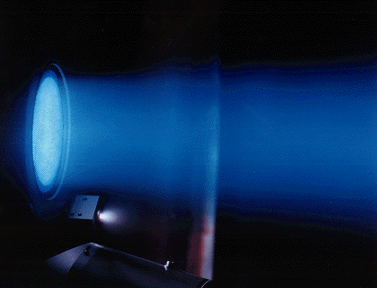(33) Ion Rockets
The ion rocket is another means of providing thrust, more gradually but also more efficiently than a conventional rocket. The material ejected here is xenon, a heavy inert gas, compressed inside strong containers (mercury vapor was also considered). As in the nuclear rocket, the energy which propels the xenon jet comes from a different source; here it is electrical energy from solar cells. The reason an ion rocket is much more efficient than ordinary rockets is the way its jet is produced. Rather than confining a hot gas in a chamber and ejecting it through a nozzle--a process limited by the temperature which the nozzle can stand--an ion rocket first strips negative electrons from the xenon atoms, leaving them as "ions", atoms with a net (positive) electric charge. The ions can now be accelerated by electrical forces, to velocities much higher than those obtained from a hot gas, but without the need for a high temperature. Inside every video tube is an "electron gun" which similarly accelerates the narrow beam of electrons that paints the video picture on the screen. Incidentally, the emerging jet of ions must be combined with a stream of negative electrons from a separate electron gun. Without this addition, only positive ions would be emitted, and the satellite would quickly become negatively charged by the stripped electrons left behind. The negative charge would then pull back the ions and undo all the work of the ion gun. Of all the exotic means of propulsion in space, this one is probably closest to practical use. The XIPS ("zips") ion engine developed by the Hughes corporation was tested in the laboratory and then aboard a Russian spacecraft, launched 6 October 1997. An experimental satellite equipped with the DS1 ion engine is due to be launched in 1999 towards the asteroid 1992KD. The mission is directed by NASA's Jet Propulsion Lab in Pasadena and will be the first in NASA's "New Millenium" series. As with solar sails, solar ion engines are mainly practical in the inner solar system, where ample sunlight is available. For more distant missions it is in principle possible to drive an ion engine by a small onboard nuclear reactor. Such reactors have already flown in space, although they are currently out of favor, in part because a reactor-equipped Russian spacecraft re-entered the atmosphere and crashed into a frozen lake in Canada. For exploring the outer solar system, however, some sort of nuclear power seems essential.
|


